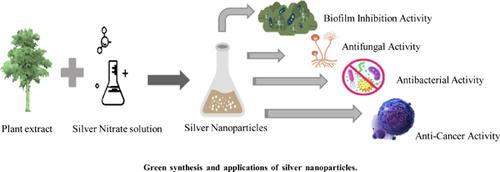Endocrine, Metabolic & Immune Disorders - Drug Targets ( IF 2.0 ) Pub Date : 2021-05-31 , DOI: 10.2174/1871530320666200729153714 Hoor Shumail 1 , Shah Khalid 2 , Izhar Ahmad 2 , Haroon Khan 3 , Surriya Amin 2 , Barkat Ullah 2

|
Nature has the potential to reduce metal salts to their relative nanoparticles. Traditionally, physical and chemical methods were used for the synthesis of nanoparticles but due to the use of toxic chemicals, non-ecofriendly methods and other harmful effects, green chemistry approaches are now employed for synthesizing nanoparticles which are basically the most cost effective, ecofriendly and non-hazardous methods. In this review, we aimed to evaluate and study the details of various mechanisms used for green synthesis of silver nanoparticles from plants, their size, shape and potential applications. A total of 150 articles comprising both research and review articles from 2009 to 2019 were selected and studied in detail to get in-depth knowledge about the synthesis of silver nanoparticles specifically through green chemistry approaches. Silver ions and their salts are well known for their antimicrobial properties and have been used in various medical and non-medical applications since the emergence of human civilization. Miscellaneous attempts have been made to synthesize nanoparticles using plants and such nanoparticles are more efficient and beneficial in terms of their antibacterial, antifungal, antioxidant, anti-biofilm and cytotoxic activities than nanoparticles synthesized through physical and chemical processes. Silver nanoparticles have been studied as an important research area due to their specific and tunable properties and their application in the field of biomedicine such as tissue and tumor imaging and drug delivery. These nanoparticles can be further investigated to find out their antimicrobial potential in cell lines and animal models.
中文翻译:

植物绿色合成银纳米粒子的研究进展
大自然有可能将金属盐还原为它们的相关纳米粒子。传统上,物理和化学方法用于合成纳米粒子,但由于使用有毒化学品、不环保的方法和其他有害影响,现在采用绿色化学方法合成纳米粒子,这些方法基本上是最具成本效益、环保和非危险方法。在这篇综述中,我们旨在评估和研究用于从植物中绿色合成银纳米粒子的各种机制的细节、它们的大小、形状和潜在应用。选择并详细研究了 2009 年至 2019 年共 150 篇包括研究和评论文章的文章,以深入了解银纳米颗粒的合成,特别是通过绿色化学方法。银离子及其盐以其抗菌特性而闻名,自人类文明出现以来,已被用于各种医疗和非医疗应用。已经进行了各种尝试以使用植物合成纳米粒子,并且此类纳米粒子在抗菌、抗真菌、抗氧化、抗生物膜和细胞毒活性方面比通过物理和化学过程合成的纳米粒子更有效和有益。银纳米粒子由于其特定和可调的特性及其在生物医学领域的应用,如组织和肿瘤成像和药物递送,已被作为一个重要的研究领域进行研究。可以进一步研究这些纳米颗粒,以找出它们在细胞系和动物模型中的抗菌潜力。已经进行了各种尝试以使用植物合成纳米粒子,并且此类纳米粒子在抗菌、抗真菌、抗氧化、抗生物膜和细胞毒活性方面比通过物理和化学过程合成的纳米粒子更有效和有益。银纳米粒子由于其特定和可调的特性及其在生物医学领域的应用,如组织和肿瘤成像和药物递送,已被作为一个重要的研究领域进行研究。可以进一步研究这些纳米颗粒,以找出它们在细胞系和动物模型中的抗菌潜力。已经进行了各种尝试以使用植物合成纳米粒子,并且此类纳米粒子在抗菌、抗真菌、抗氧化、抗生物膜和细胞毒活性方面比通过物理和化学过程合成的纳米粒子更有效和有益。银纳米粒子由于其特定和可调的特性及其在生物医学领域的应用,如组织和肿瘤成像和药物递送,已被作为一个重要的研究领域进行研究。可以进一步研究这些纳米颗粒,以找出它们在细胞系和动物模型中的抗菌潜力。比通过物理和化学过程合成的纳米颗粒具有抗生物膜和细胞毒活性。银纳米粒子由于其特定和可调的特性及其在生物医学领域的应用,如组织和肿瘤成像和药物输送,已成为一个重要的研究领域。可以进一步研究这些纳米颗粒,以找出它们在细胞系和动物模型中的抗菌潜力。比通过物理和化学过程合成的纳米颗粒具有抗生物膜和细胞毒活性。银纳米粒子由于其特定和可调的特性及其在生物医学领域的应用,如组织和肿瘤成像和药物递送,已被作为一个重要的研究领域进行研究。可以进一步研究这些纳米颗粒,以找出它们在细胞系和动物模型中的抗菌潜力。











































 京公网安备 11010802027423号
京公网安备 11010802027423号